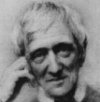1. Babylon (Genesis 11,1-9)
Babylonian sources and confirmation from all Semitic languages justify but one derivation for the word Babylon. The Semitic components of the name are: 'bab' (gate) and 'il' (God). Babel means simply "Gate of God", and no Semite, whether Babylonian, Ugaritic or Hebrew, could miss its meaning.
Yet in Genesis a different explanation of the name is given. The author first narrates the fantastic attempt of humankind to build a tower reaching into heaven. Here he obviously alludes to the well-known ziggurat (multi-storeyed) temples at Babylon. Then he reports on God's counter-measure: the confusion of human speech into many languages. The author concludes: "Therefore its name was called Babel, because there the Lord confused (Hebrew: 'balal'} the language of the earth" (Genesis 11/9).
It is obvious that the story originated from popular imagination! The fact of the diversity of languages all over the world required an explanation. Human pride, such as manifested in the Babylonian temples, must have been the cause! With a little stretch of the imagination 'Babel' can be seen as a pun on 'confusion' (Hebrew: 'Balal'). From this grew the story which attributes the confusion of language to God's intervention at Babel!
2. Jacob (Genesis 25,19-34)
The struggle between Jacob (the Jewish patriarch) and Esau (ancestor of the Edomites) greatly appealed to Israelite imaginations. According to one tradition they wrestled even in the womb of their mother Rebekkah. Their fight apparently concerned the life-long superiority of whoever was going to be born first. The tension rises when an oracle informs Rebekkah that in actual fact 'the elder shall serve the younger'. Then the moment of birth has come :
'The first came forth red.... Esau;
Afterwards his brother came forth, and his hand
had taken hold of Esau's heel (°aqeb);
so his name was called Jacob" (Hebrew: Ja° aqob)
(Genesis 25,26)
When Jacob eventually manages to secure the rights of the firstborn son from his elder brother by 'stealing' his father's blessing, Esau complains, punning on Jacob's name:
"Esau said : 'Is he not rightly named Jacob ? For he has
supplanted me (Hebrew: ya° aqebeni)
these two times. He took away my birthright;
and behold, now he has taken away my blessing!"
Gen.( 27/36) (
The name Jacob is interpreted by him as 'supplanter', deriving it from the Hebrew root °aqab.
Comparative study of names leaves no doubt as to the fact that the original form of the name was 'Ya°aqob-'el' As such the name occurs on Egyptian scarabs dating from the Semitic Hyksos-dynasty and in ancient Babylonian records. Moreover, the full name has been rediscovered in the Hebrew text of Deuteronomy 33/28 which should read:
"So Israel dwelt in safety,
undisturbed the fountain of Jacob-el 1"
(D. N. Freedman,
Israel Exploration 13 (1963) pp. 125-126).
The meaning of this name is "May God (='el) protect (=ya°aqob)". When the name was abbreviated by dropping the ending 'el', the interpretation of the name gave rise to speculation and the creation of aetiologies. The shrewd character ascribed to Jacob in the popular traditions originated with the fanciful interpretations of his name!
There are many examples of such stories in the Old Testament. Reflection on a name (e.g. Babylon) and its characteristics (e.g. racial pluriformity) are expressed in the form of a story (the tower of Babel). An aetiology is not a literal account of things that happened, therefore, but a reflection on key features of a place or a person. An aetiology is a peculiar literary form that needs careful analysis to uncover its meaning.
This also applies to the punishments described after the story of the Fall (Genesis 3,14-19).
Punishment of the serpent -
Genesis 3,14-15 |
Yahweh God said to the serpent:
"Because you have done this, be accursed beyond all cattle, all wild beasts.
You shall crawl on your belly and eat dust every day of your life.
I will make you enemies of each other: you and woman, your offspring and her offspring.
It will crush your head and you will strike its heel."
|
1. People had noticed how snakes have no legs. Snakes were thought to eat dust.
2. People were also struck by the hostility of everyone (especially housewives!) to snakes.
Popular explanation was that the snake must have done something terrible for which it was punished by God. This gave rise to the story of how the snake seduced the woman. |
Punishment of the woman -
Genesis 3,16
|
To the woman he said:
"I will multiply your pains in childbearing, you shall give birth to your children in pain.
You will desire for your husband, yet he will rule over you."
|
People had been struck by the fact that women suffer pain at childbirth & that they are usually dominated by men.
The popular explanation was that women were being punished for some crime they had committed. It led to story of Eve's involvement in the Fall. |
Punishment of the man -
Genesis 3,17-19 |
"Accursed be the soil because of you. With suffering you shall get your food from it every day of your life. It shall yield you brambles and thistles, and you shall eat wild plants. With sweat on your brow shall you eat your bread, until you return to the soil as you were taken from it. For dust you are and to dust you shall return." |
People had been wondering why life was so hard and why everyone eventually dies.
They saw the explanation in punishment given by God for some sin. This was expressed in the story of the Fall. |
Consequences of this analysis:
*
The story of the Fall should not be taken literally. There was no garden of Eden, no tree of life, no serpent, no eating of the fruit by human ancestors. The story expresses the fact that the human race is in a situation of sin - which is true.
* The 'punishments' should not be taken literally as a curse inflicted by God, rather they express the situation men and women are in.
*
It is entirely wrong to infer that social domination of men over women is something expressly willed by God.
Moreover,
whatever the view of the Old Testament author of Genesis 2,3b - 3,24, in the New Testament the fundamental equality of men and women had been established.
"You have put off your old nature with its practices.
You have put on a new nature
which is being renewed in knowledge
in the image of its creator.
In that image there is no room for distinctions
between Greek and Jew, circumcised and uncircumcised,
between barbarian and Scythian,
slave and free.
But Christ is all, Christ is in all."
Colossians 3,9-11
"Neither circumcision matters, nor uncircumcision,
but whether you are a new creature . . . .
For all of you who have been baptised in Christ,
have put on Christ.
There is neither Jew nor Greek,
neither free nor slave,
neither male nor female.
For you are all one in Christ Jesus."
Galatians 6,15; 3,27-28









